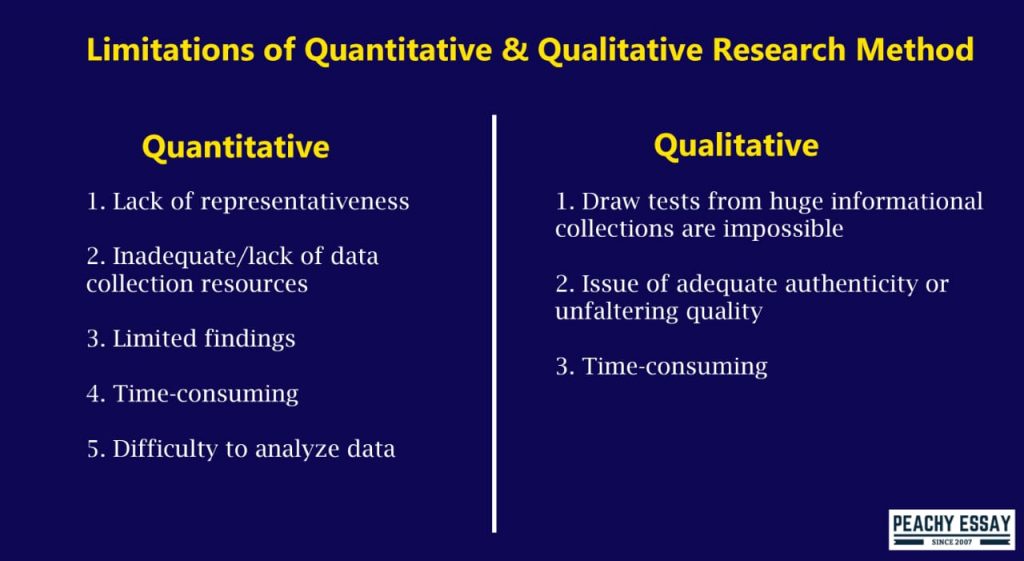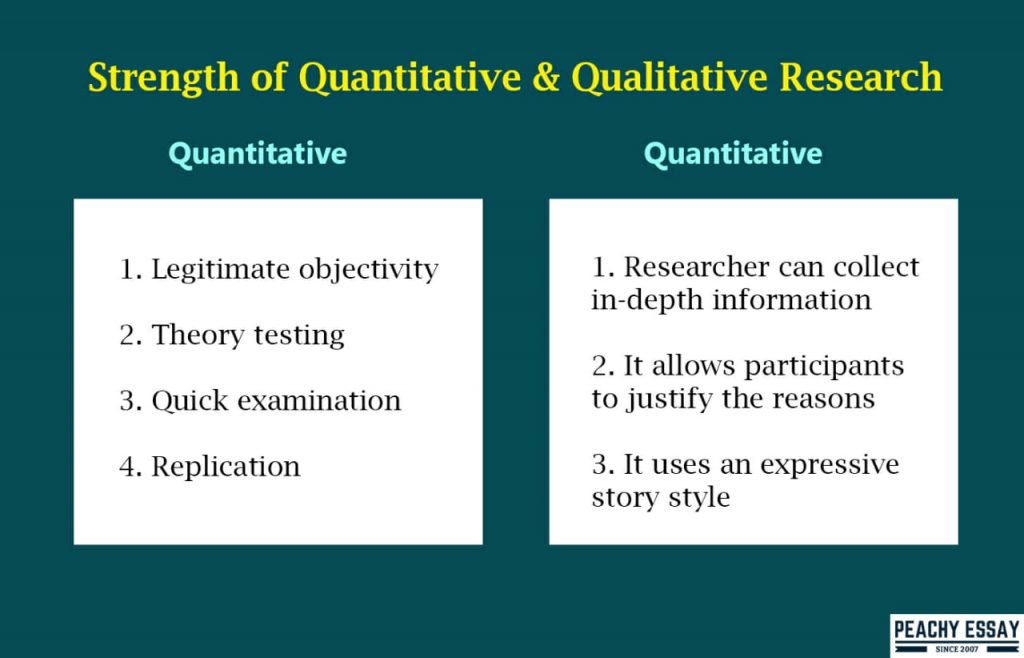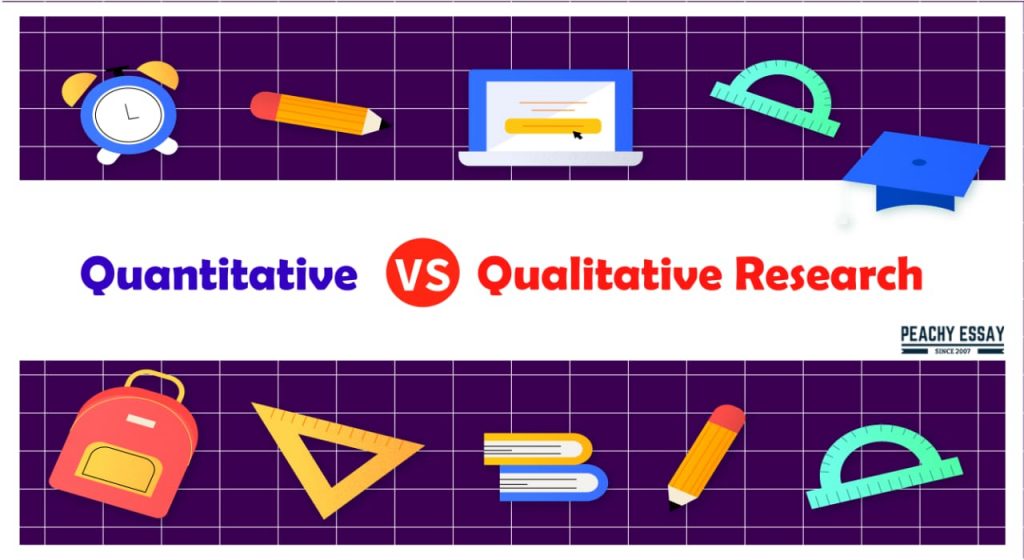Quantitative research refers to information regarding numerical data, whereas qualitative one encompasses descriptive aspects regarding the phenomenon that can be seen but not quantified.
When assembling and analysing data, quantitative investigation oversees numbers and bits of knowledge, while subjective exploration entails words and suggestions. Both are significant for procuring different sorts of data.
In this guide, you will get in-depth information about these types of research.
What is Quantitative Research?
Quantitative research is a technique used to collect and analyze numerical data to find patterns, test hypotheses, and generalize results to a wider population. Under this approach, data is collected from respondents through online surveys or questionnaires.
An example of quantitative research can be a study conducted to find out the amount of time a bank teller takes to serve a customer.
When data is collected from a large sample, it represents the population, and the results achieved from it are logical and unbiased. The essence of quantitative research is to examine causal relationships between variables, make predictions, and generalize research findings to the population.
Quantitative Research Methods
Quantitative research methods refer to approaches used to ensure objectivity in measurements and numerical analysis of data. The focus of quantitative research is to collect, analyze, and generalize results to a wider population. Through this research approach, you can easily establish the relationship between variables and make decisions based on the findings.
A quantitative study can either be descriptive or experimental. If you want to establish the relationship between variables, you should adopt the descriptive study; however, to find out causality between variables, you have to use an experimental study.
Quantitative Data Analysis
Quantitative data analysis can be challenging if you don’t know how to go about it. Students, who are unfamiliar with statistics jargons like correlation, variance, mean, median, etc., find it intimidating when learning about data analysis.
Quantitative data analysis deals with numbers or data that can be converted to numbers with no loss of any meaning. With this analysis, you can determine the difference between groups; establish a relationship between variables, and test hypotheses
Key highlights
- Quantitative scientists endeavour to control accidental components by coordinating their assessments in the lab.
- The analysis is focused on objectivity
- The larger the sample size, the more it represents the population
- Use standardized research tools and contains measurable variables
- Data presentation is done via graphs, frequency tables, and pie-charts
Limits of Quantitative Research
Here are the limitations of the quantitative research method
- Lack of representativeness: the representativeness of the sample is based on many aspects, such as the sample size. Due to logistical and economic factors, it may be challenging to collect data from the right sample, which hinders the representativeness of the sample.
- Inadequate/lack of data collection resources: Due to lack of resources, it may be difficult to cover a large sample size.
- Limited findings: Quantitative research entails collecting data using closed-ended questions. This makes it challenging to collect in-depth information.
- Time-consuming: In quantitative research, you have to collect data from large sample size to enhance representation. Dealing with a large sample is time-consuming and costly.
- Difficulty to analyze data: Sometimes, quantitative research requires sophisticated data analysis, which is hard for researchers with little mathematical knowledge.
Strength of Quantitative Research
Legitimate objectivity: You can easily translate data with a genuine examination, and since experiences depend on math, the approach is considered to be objective
- Theory testing: It is ideal for testing and endorsing recently constructed theories
- Quick examination: Sophisticated programming takes out a critical piece of the necessity for postponed data assessment, especially with tremendous volumes of data included
- Replication: Quantitative data relies upon assessed values and can be checked by others considering the way that mathematical information is devoid of ambiguities.
Hypotheses can similarly be tested considering the usage of quantifiable assessment.
What is Qualitative Research?
Qualitative research is conveyed in non-numerical terms. It is utilized to get ideas, examinations, or encounters. This sort of assessment engages you to collect adequate information on unknown focuses.
The techniques incorporate meetings with open-ended inquiries, perceptions portrayed in words, and writing surveys investigating ideas and hypotheses.
Qualitative investigation is the route toward social occasion, researching, and unravelling non-numerical data, similar to language. Subjective exploration can see how people uniquely see and offer significance to their social reality.
The approach is described using non-numerical data derived from different data collection methods, such as interviews, focus groups, etc.
Qualitative investigation is multimethod in the centre, including an interpretive, naturalistic approach to manage its subject. This suggests that abstract investigators study things in their normal settings, trying to figure out or interpret phenomena in regards to the ramifications people bring to them.
Qualitative Research Methods
There are different sorts of subjective investigation techniques, including interviews, records, focus groups, and contextual analyses. The outcomes of abstract procedures provide a significant cognizance of how individuals conduct themselves in a social world.
A subjective investigation strategy would entail interviews that make abstract information through interviewing. This approach permits respondents to talk freely and independently.
Qualitative Data Analysis
This approach is relentlessly interpretive, and through it, you can gather in-depth data from the field. Subjective analysis is fabricated, and various methodologies can be used to analyze data, such as content analysis and grounded theory.
Key highlights
Events can be seen sufficient simply if they are tracked down the in setting. In like manner, an abstract expert douses her/himself in the field, in ordinary natural components. The settings of solicitation are not envisioned; they are a trademark. The researcher doesn’t predefine anything.
Subjective scientists need people who are prepared to address themselves, to give their perspectives in words and various exercises. Thusly, subjective exploration is an insightful cycle where individuals considered show the expert their lives.
The plan of the examination develops during the exploration and can be changed or changed as it advances.
There is no single reality; it is unique and exists just about the onlooker.
The theory is based on data and emerges as an element of the investigation
Limitations of Qualitative Research
Because of the time and costs included, subjective plans don’t draw tests from huge informational collections.
The issue of adequate authenticity or unfaltering quality is a critical investigation. It is hard to apply regular norms of dependability and legitimacy standards because of subjective data’s theoretical nature and its source in single settings.
For example, because of the expert’s central occupation in the time of data, it is silly to hope to copy abstract analysis.
It is time-consuming to collect data through in-depth interviews where many participants are involved.

Strengths of Qualitative Research
The researcher can collect in-depth information and discover details that would have not been identified through the positivist approach.
The research framework can be adjusted as new information emerges
The subjective examination allows participants to justify the reasons behind their conduct, which allows the researcher to make informed decisions
The qualitative investigation uses an expressive story style; this assessment might be of explicit benefit to the specialist as she or he could go to abstract reports to dissect sorts of data that be may somehow be difficult to reach, appropriately gaining new arrangement.

Contrasts Between Quantitative and Qualitative Research
Quantitative and qualitative data differs a lot. If you are interested in collecting data to test your hypothesis or determine the relationship between variables, it is advisable to use the quantitative approach. However, if you want to understand more about the characteristic of a phenomenon, it is advisable to use qualitative research.
Here are the contrasts between the two:
- Conceptual
Subjective data is tied in with understanding humans direct from the onlooker’s perspective. Quantitative information is about finding information about a phenomenon.
- Methodological
In qualitative, data is accumulated through part discernment and gatherings. Topics from depictions by sources break down information.
In quantitative, data is assembled through assessing things and took apart through numerical assessments and quantifiable derivations.
- Methods of collecting data
Qualitative and quantitative data can be assembled through different procedures. It is basic to utilize arrangement methodology to respond to your exploration question.
Various data variety methods can be either subjective or quantitative. For example, in examinations, discernments, or logical examinations, your data can be tended to as numbers (e.g., using rating scales or checking frequencies) or words (e.g., with open-finished requests or portrayals of what you notice).
Methods of Collecting Quantitative Data
- Surveys: Encompasses the use of structured and semi-structured questionnaires to collect data.
- Experiments: This is where data is collected under a controlled environment.
- Observations: This is one of the best methods of collecting data from a natural environment.
Methods of Qualitative Data Collection
- Interviews: Interviews allow you to collect in-depth information from respondents through interview guides.
- Focus groups: Discussion among people about a subject to collect their opinions for extra investigation.
- Ethnography: Taking part in a social group or community to collect data without the knowledge of members
- Writing audit: This involves the survey of published works by different authors.
When to Utilize Qualitative or Quantitative Research
Here is when to use either qualitative or quantitative research:
Use quantitative assessment if you need to affirm something or test hypotheses.
Use qualitative examination if you want to gather in-depth information about people’s opinions on something.
For most assessment subjects, you can pick a subjective, quantitative, or mixed procedures approach. The sort you pick depends upon, notwithstanding different things, such as research questions, time, money, and respondents’ acceptance.
Quantitative assessment approach
Suppose you collected data from 500 students at your college using the question, “On a scale of 1-5, how satisfied are you with your lecturers?”
“In general, understudies assessed their instructors 4.4”.
Qualitative investigation approach
Assume you collected qualitative data from15 understudies using the question, “How contented are you with your assessments?”, “What is the most awesome aspect of your examination program?” and “How might be managed to improve the examination program?”
Considering the suitable reactions you get, you may ask follow-up questions for clarification. You decipher all gatherings using record programming and endeavour to find shared qualities and models.
Mixed procedures approach
Suppose you conduct interviews to determine the level of student’s satisfaction with their examination. Through open-ended questions, you discover insights you never expected and get new experiences. Subsequently, you use an investigation to test these encounters to a greater degree.
Frequently Asked Questions
How is qualitative different from quantitative method?
Quantitative investigation oversees numbers and experiences, while subjective assessment oversees words and suggestions.
Quantitative methodologies allow you to test a hypothesis by proficiently assembling and separating data, while abstract strategies license you to examine musings and encounters all around.
What is blended strategies research?
In mixed methodologies research, you use subjective and quantitative data arrangement and assessment procedures to react to your exploration question.
How might I pick which research strategy to use?
The exploration methods you use depend upon the sort of data you need to react to your examination question.
In the event that you need to check something or test a hypothesis, use quantitative strategies. In the event that you need to explore considerations, examinations, and suggestions, use qualitative methodologies.
In the event that you need to analyze a ton of expeditiously open data, use secondary information. In the event that you need data express to your inspirations with authority over how it is delivered, assemble fundamental data.
On the off chance that you need to decide circumstances and logical results connections between factors, use experimental strategies. If you need to fathom an investigation subject’s characteristics, use descriptive techniques.
What is data collection?
It is the process of collecting information and assessments in research. It is used in different settings by scholastics, governments, associations, and various affiliations.
How do you analyze qualitative data?
Qualitative data can be analysed through content analysis, thematic analysis, or grounded theory.
There are various approaches to manage subjective data, yet they all offer five phases in like way:
- Prepare your information.
- Audit and research your data.
- Build up a data coding system.
- Relegate codes to the data.
- Recognize rehashing topics.




